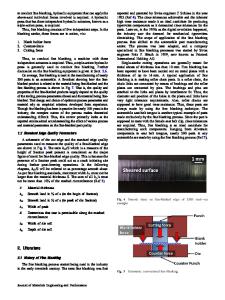Numerical Simulation on Edge Crack of Advanced High-Strength Steel Considering Blanking Induced Damage
- PDF / 2,033,866 Bytes
- 8 Pages / 593.972 x 792 pts Page_size
- 28 Downloads / 271 Views
JMEPEG https://doi.org/10.1007/s11665-020-05260-4
Numerical Simulation on Edge Crack of Advanced High-Strength Steel Considering Blanking Induced Damage Xiangyu Yu, Jun Chen, and Bowen Zhang Submitted: 10 March 2020 / Revised: 5 July 2020 / Accepted: 7 October 2020 Sheet metal blanking is an indispensible process for stamping process widely used in automotive industry and home appliances. The damage induced by blanking becomes an important factor that may affect the sheet metal formability and cause edge crack. Conventionally, blanking process is simulated by solid element, while forming processes are simulated by shell element, and it is necessary that the damage legacy data transfer from blanking process simulation to forming process simulation so that the forming processes, especially edge crack can be simulated more accurately. In the present work, a new simulation method is proposed to predict edge crack in stamping of advanced high-strength steels considering blanking history. Blanking simulation is first conducted to obtain residual damage values near the blanked edge area, which will be further mapped onto the shell elements near the blanked edge in forming simulations. Several 3D numerical models of hole-expanding and drawing based on shell element are established to investigate crack during stamping and verified by experiments. The results show that the proposed method can efficiently predict the edge crack more accurately. Keywords
advanced high-strength steel, blanking, edge crack, hole-expanding, numerical simulation
1. Introduction More and more advanced high-strength steels (AHSS) are utilized in automotive industry due to the increasing demands of energy saving and environment protection (Ref 1). Although AHSS show good combination between strength and formability, lots of efforts have been made to solve the stamping problems of AHSS, such as spring back, die wear and fracture. Edge crack is a kind of failure which usually appears in holeexpanding and curve flanging. Cutting or blanking makes the quality of the sheet edge worse than that undamaged, which makes it more difficult to predict failure by forming limit diagrams (FLD) or ductile fracture criteria (DFC) (Ref 2). Hole-expanding experiment is to expand a hole with conical, spherical or flat punch to failure (Ref 3). Several groups performed systemic experiments and built models to predict the fracture. Comstock (Ref 4) discovered that high strength makes hole-expanding ability lower in ferritic stainless steel and austenitic stainless steel. Milosevic and Moussy (Ref 5) observed that the critical fracture strain of the sheared edge is influenced the strain hardening and void deformation. Konieczny and Henderson (Ref 6) performed series blanking and hole-expanding experiments to evaluate effect of the Xiangyu Yu and Bowen Zhang, State Key Laboratory of Deep-Sea Manned Vehicles, China Ship Scientific Research Center, Wuxi 214082, China; and Jun Chen, Department of Plasticity Technology, Shanghai Jiao Tong University, Shanghai 200030, China. Contact e
Data Loading...











